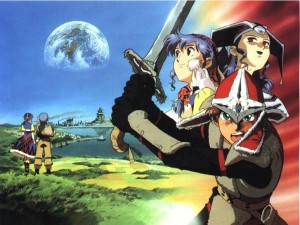 No conversation about the Sega Genesis can go on for long without referencing Game Arts. As one of those developers who were strongly identified with a particular game console (think Square and Nintendo), Game Arts threw most of its programming weight behind the struggling Sega CD. The strong relationship between it and Sega lasted well in to the Dreamcast era, and the legacy the company left for Sega fans is immense. Lunar, Silpheed, Grandia, Gun Griffon – all are franchises that are indelibly linked to Sega. These classic series also have something else in common: They were all directed by Takeshi Miyaji.
No conversation about the Sega Genesis can go on for long without referencing Game Arts. As one of those developers who were strongly identified with a particular game console (think Square and Nintendo), Game Arts threw most of its programming weight behind the struggling Sega CD. The strong relationship between it and Sega lasted well in to the Dreamcast era, and the legacy the company left for Sega fans is immense. Lunar, Silpheed, Grandia, Gun Griffon – all are franchises that are indelibly linked to Sega. These classic series also have something else in common: They were all directed by Takeshi Miyaji.
Miyaji, who passed away in July of 2011 at age 45, was the director and founder of Game Arts. He was born in Tokyo in December of 1965 and began his gaming career by programming for PET2001. Ambition came to Miyaji at an early age, and by his fifteenth birthday he was already in the industry, getting his start in programming at ASCII. There, he quickly developed a knack for finding what worked and how to make things happen, and before long he had published a book on the subject. It wasn’t long before he felt the need to strike out on his own, and after only four years at ASCII, he made the decision to start his own company.
Together with his brother Yoichi, Miyaji founded Game Arts in 1985 after graduating from Fukoaka High School in Saitama Prefecture, a bold move for someone who was only 19 years-old. Miyaki stated that he had started Game Arts with the intention of producing more than just gaming software, saying he wanted to prove to the world that games could indeed be art, and he focused all his energy into developing titles that realized this ambitious goal. With few resources and even less money, the siblings began programming games for computers.
Game Arts started small, working on titles for the PC-8801 that mostly remained in Japan. Thexder and Cuby Panic were its first two games, both released for PCs in 1985. The group continued to make computer games for the next six years, until it shifted focus to consoles. The hardware that most stood out in its eyes were the Genesis and its newly-released add-on, the Sega CD, and Game Arts began its love affair with Sega machines with Tenka Fubu, a military strategy game set in feudal Japan. Miyaji and co. didn’t approach the console market with kid gloves, and they weren’t planning on selling their products exclusively in Japan. The first game they released for western Sega audiences was the excellent Alisia Dragoon, which many gamers fondly remember for its solid gameplay and excellent visuals and sound. This was followed by the first major RPG for the Sega CD, a game with which Miyaji would make his mark. Lunar the Silver Star instantly gave many gamers who had forked over $300 for the expensive add-on a reason to be happy they had done so. The game was unlike anything on the machine, and it sported music and cut scenes that none of the Genesis’ competitors (except for the TurboGrafix-16 CD-ROM) could match. Miyaji served as designer on Lunar, which eventually sold out its entire production run in a year, almost selling with the Mega CD system on a 1-1 basis. The game became a media darling, garnering the accolades of many video game magazines, including GameFan’s award for best RPG of 1993.
Spurred on by success of Silver Star Story, Miyaji continued to head projects that would elevate Game Arts to the forefront of Sega-related developers and the industry in general. Several more titles were released for the Mega CD, but none of them left Japan. The next Game Arts software to make the jump over the Pacific was a remake of the company’s third title, Silpheed, which had originally come out in 1987 and was hailed for its impressive polygon graphics. The game was given a total overhaul for the Sega CD, adding full-motion video backdrops to the already impressive polygons. The result was a visual tour-de-force that left gamers in awe at the Sega CD’s visual power, something very few games had thus far demonstrated. The game was met with critical and commercial success, with many in the press comparing it directly to Nintendo’s Starfox (despite the October, 1993 issue of Electronic Gaming Monthly referring to the backgrounds as “digital wallpaper”). Over the next 16 years, Miyaji would go on to direct and produce some of the most legendary titles on the Sega CD,Saturn, and Dreamcast, including the classic Lunar Eternal Blue, which continued the unique story-telling of the first and added more cut scenes and a deeper quest. It eventually went on to become the third best-selling Sega CD title of all time (behind its predecessor and Sonic CD).
 When Sega finally moved on to the Saturn, Miyaji and Game Arts followed. New versions of the Lunar games were released, adding back in the nearly third of each that had been cut out of the Sega CD originals, and new properties were introduced. Gun Griffon was a sorely-underrated mech action series that only saw one release in America, but it was Miyaji’s next RPG opus that would really make gamers take note of Game Arts’ power. Grandia was a simply massive RPG that pushed the Saturn nearly to tears, and even those who imported it felt the depth of its story and the warmth of its characters. It was later released on the Playstation, allowing a larger portion of gamers to enjoy Miyaji’s excellent work.
When Sega finally moved on to the Saturn, Miyaji and Game Arts followed. New versions of the Lunar games were released, adding back in the nearly third of each that had been cut out of the Sega CD originals, and new properties were introduced. Gun Griffon was a sorely-underrated mech action series that only saw one release in America, but it was Miyaji’s next RPG opus that would really make gamers take note of Game Arts’ power. Grandia was a simply massive RPG that pushed the Saturn nearly to tears, and even those who imported it felt the depth of its story and the warmth of its characters. It was later released on the Playstation, allowing a larger portion of gamers to enjoy Miyaji’s excellent work.
The Dreamcast brought out Game Arts most anticipated release, Grandia II, and Miyaji was quick to take advantage of the Internet for marketing and discussing his work. His vision to anticipate the direction of RPGs was made apparent during an appearance at the 2000 Ubi Soft Gamer’s Day outing, where he said that in five years the gaming landscape would be quite different. “There are three keywords: network, multiplayer, and story,” He explained. “After four or five years, those three aspects will really play a big role, and additionally, games that have more fun elements will be the kind of game that users will support.” A hit on the Dreamcast, Grandia II was eventually ported to the Playstation 2.
Sega’s departure from the hardware business brought an end to a partnership that had produced some of the best games of the ‘90s, and Game Arts evolved to produce software for other consoles entirely. Unfortunately, though the company’s productivity remained consistent, its creative fire seemed dimmed. The Lunar remakes that had been so well received were followed by a string of side stories that always left fans anxiously awaiting the third installment in the series, one which never came. In 2010, Game Arts producer Masato Dobashi hinted at a possible continuation of the story when he stated that the development of a third game depended on the fans. Lamentably, he failed to elaborate on what he meant, and no announcement has been made about a possible sequel since that time. Game Arts continued to explore the Grandia universe with two more sequels, and both Gun Griffon and Silpheed maintained a presence on retail shelves, but the magic touch just wasn’t there. In fact, one of Miyaji’s last efforts with GA was as planning producer and 3D engine designer for the Playstation 2 release Silpheed: The Lost Planet, another re imagining of the landmark title, which was co-developed with Treasure and released in America by Victor Ireland’s old company, Working Designs.
The reason for the change that afflicted Game Arts came from Miyaji leaving in 2000 to form a new company called G-Mode, dedicated to producing software for the mobile phone market. Once again, he saw the changing winds of the industry and moved to get ahead of the pack. During his 11-year tenure as its Executive Director, Miyaji oversaw a profitable business that not only strove to produce cutting-edge mobile gaming but also sought to bring some of that console magic of yesteryear back to the industry. In 2004, G-Mode acquired the rights to most of the back-catalog of defunct publisher Data East, and it has been re-releasing many classic arcade hits through online services like the Nintendo Wii Virtual Console and Gametap. A compilation was released for the Nintendo Wii in 2010, and rumors persist of a second volume.
 Game Arts has soldiered on in Miyaji’s absence, guided by his brother. It still creates games for consoles, but there is (as of this writing) still no Lunar 3. One of the biggest releases involving the company came in the form of a game that wasn’t officially a full Game Arts project. Shortly after Nintendo announced the development of Super Smash Bros. Brawl, the third game in its popular mascot-centric fighting series, for the Wii at E3 in 2005, some Game Arts staff were hired by director Masahiro Sakurai. In turn, G-Mode has risen to become a solid company in its own right, but it suffered a major blow when Miyaji was found dead in his apartment on July 29, 2011. No reason has yet been given for his death, and Ryu Okoriyama has since become G-Mode’s CEO.
Game Arts has soldiered on in Miyaji’s absence, guided by his brother. It still creates games for consoles, but there is (as of this writing) still no Lunar 3. One of the biggest releases involving the company came in the form of a game that wasn’t officially a full Game Arts project. Shortly after Nintendo announced the development of Super Smash Bros. Brawl, the third game in its popular mascot-centric fighting series, for the Wii at E3 in 2005, some Game Arts staff were hired by director Masahiro Sakurai. In turn, G-Mode has risen to become a solid company in its own right, but it suffered a major blow when Miyaji was found dead in his apartment on July 29, 2011. No reason has yet been given for his death, and Ryu Okoriyama has since become G-Mode’s CEO.
Though he died much too young, Takeshi Miyaji has left a legacy in the gaming industry that few can match. He was directly involved in several legendary franchises, and his business acumen led to the founding of two highly successful companies. We can only hope that gamers continue to enjoy the fruits of his genius for years to come, for as sad as it is to hear of Miyaji’s untimely death, it would be even sadder for his great creations to be forgotten.
Sources:
- Douglas, A. & Meston, Z. (1993). Lunar the Silver Star: The Official Strategy Guide. Sandwich Island Pub.
- Fujii, M. (2010, March 1). Game Arts Interview: The Future of Lunar 3 Will Depend on the Fans. Examiner.
- Game Arts Company Information. (2010). Game Arts Official Website.
- History of Data East. (2009). History of Data East. Dataeastgames.
- IGN Staff. (2000). Q&A with the Producers of Grandia 2. IGN.
- Iwata asks: Super Smash Bros. Brawl. (2011).Wii.com.
- Silpheed review. (1993, October). Electronic Gaming Monthly, 6(10).
- Sterling, J. (2011). Grandia Creator Takeshi Miyaji Dies Aged 45. Destructoid.

Very good article Ken, I didn’t realize that they made so many great games!